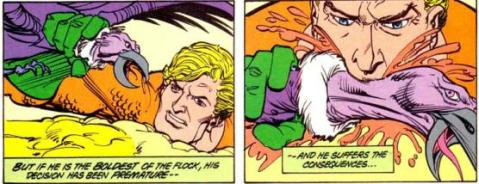Archive for the ‘WTF Is’ Category
WTF Is: DC Challenge
Posted on: May 12, 2010
- In: WTF Is
- 2 Comments
 How have I never seen this before? DC Challenge seems like it’d be so far up High Five’s alley, I’m pretty sure it has to buy us breakfast in the morning. Check it.
How have I never seen this before? DC Challenge seems like it’d be so far up High Five’s alley, I’m pretty sure it has to buy us breakfast in the morning. Check it.
According to legend (or the back pages of issue one, whichever), Len Wein, Gerry Conway, Marv Wolfman, Mark Evanier, Bill Rotsler, and Bill Warren all ended up piss-drunk at some Marvel party at the Executive Hotel during 1983’s San Diego Comic Con. Describing it as a “sauna,” they all retreated to the roof to air out a bit. While up there, Evanier suddenly came up with the idea for a year long round-robin style maxiseries between eleven DC writers and twelve DC artists, announced it, and got the ball rolling. By the time security showed up and kicked them off the roof, Dick Giordano had approved the project and the order of collaborators was set: Evanier, Wein, Doug Moench, Paul Levitz, Mike Barr, Elliot Maggin, Paul Kupperberg, Conway, Roy Thomas, Dan Mishkin, and Marv Wolfman (with Cary Bates) would write while such DC greats as Carmine Infantino, Gil Kane, Dave Gibbons, Giordano, Don Heck, Curt Swan, Keith Giffen, George Perez and others (goddamn!) would tackle the art.
Finally, the rules were established. Each issue would end in a near impossible cliffhanger (or five) that the next author would have to figure out how to fix. The previous author would also get to name the next issue, which would have to tie in at some point. Meanwhile, the two writers couldn’t talk to each other about the project at all. Considering that this book was pretty much a gigantic experimental exercise in comic writing, the authors started getting just plain sadistic trying to fuck each other over with titles such as “If This is Love, Then Why Do My Teeth Hurt?” and “If There’s a Hole in Reality, Is Life a Cosmic Donut?”
Writers could use any characters from the DCU with the exception of any they were writing for at the time. This led to a ton of awesome rarely-used Golden and Silver Age characters popping up such as the Space Cabby, Darwin Jones, Son of Vulcan, and Woozy Winks. Considering that between it’s conception in 1983 and it’s actual release starting in November 1985, that whole Crisis on Infinite Earths thing started making this so non-canon. As a matter of fact, this really kind of helped make DC Challenge a send off to the multiverse.
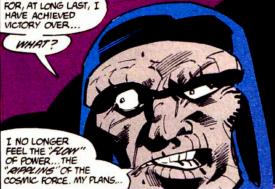 So, what’s it all about? Well, that’s a bit of a clusterfuck. A race of aliens known as the Moltanians discover that when they die their souls inhabit the bodies of demons in the netherworld. A Moltanian named Bork started the Black Counsel, whose intention was to transport the demons to both Rann and Earth, where the “fabric of reality is much thinner” (thanks to a half-melted Darkseid, apparently). The Guardians of the Universe try their damnedest to prevent it and end up hiring another Moltanian named Kaz to fix everything. Easy enough, right?
So, what’s it all about? Well, that’s a bit of a clusterfuck. A race of aliens known as the Moltanians discover that when they die their souls inhabit the bodies of demons in the netherworld. A Moltanian named Bork started the Black Counsel, whose intention was to transport the demons to both Rann and Earth, where the “fabric of reality is much thinner” (thanks to a half-melted Darkseid, apparently). The Guardians of the Universe try their damnedest to prevent it and end up hiring another Moltanian named Kaz to fix everything. Easy enough, right?
Yeah, not really. They try to fix shit by sending a bunch of the heroes to different periods in time where they think they’ll do better. Instead, the Nazis find a spaceship sent back with the Blackhawks and win World War II. Uh, hooray?
As a whole, this book suffers from that old adage “too many cooks in the kitchen.” In theory, yeah, having all these well known writers and artists on one project would be totally awesome! In practice, you get “We Are the World.” In the back of the last issue, DC Challenge‘s Robert Greenberger summed it up when he muses about how “Amazing Heroes says we’re exploitive and Comic’s Journal complains we don’t make any sense.” No shit, it doesn’t make any sense! I mean, how does Aquaman hydrate himself after getting trapped in the middle of the Sahara Desert?
Granted, this book is an interesting (albeit accidental) bookend to the pre-Crisis DCU. Unfortunately, it didn’t seem like the finished product was as glorious as intended by those drunken rooftop comic writers. It does raise the question, though: What would happen if DiDio went ahead and gave the okay to a DC Challenge 2?
Oh, right. “We Are the World 25 for Haiti.”
WTF Is: Zero Hour
Posted on: March 30, 2010
- In: WTF Is
- 3 Comments
 We all know how much the publishing houses love their events. Hell, at last year’s San Diego Comic-Con, there wasn’t a single DC, Marvel, or Image panel that didn’t ramble on and on about how great Blackest Night, Siege, or Image United were gonna be. But in 20 years, will people really give a shit about any of that? Or will they just be really confused when an older comic writer references it in a book? Yeah, it’s the latter. Well, that’s what “WTF Is” is all about: explaining what happened in all the events from the past that didn’t really live up to the glory of, oh, Crisis on Infinite Earths or something.
We all know how much the publishing houses love their events. Hell, at last year’s San Diego Comic-Con, there wasn’t a single DC, Marvel, or Image panel that didn’t ramble on and on about how great Blackest Night, Siege, or Image United were gonna be. But in 20 years, will people really give a shit about any of that? Or will they just be really confused when an older comic writer references it in a book? Yeah, it’s the latter. Well, that’s what “WTF Is” is all about: explaining what happened in all the events from the past that didn’t really live up to the glory of, oh, Crisis on Infinite Earths or something.
And, speaking of a DCU crisis, doesn’t it seem like 1994’s Zero Hour: Crisis in Time would be the perfect place to start?
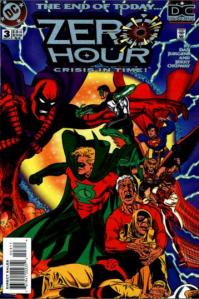 Zero Hour is the story of the DCU vs. Extant. Sort of? Yeah, this is one of those books where they tried to get as much shit to happen in as few pages as possible. Here’s the best way I can explain it. During Armageddon 2001 (which almost deserves a “WTF Is” of its own), a character named Waverider goes back in time to the year 2001 to try and destroy an evil being named the Monarch before he can kill all the superheroes around 2030. During that event, the Monarch captured Hank “Hawk” Hall and Dawn “Dove” Granger, eventually executing Dove and making Hank go crazy. The Monarch then revealed himself to be a future version of Hank, driving Hank to kill the Monarch, steal his armor, and take up the Monarch mantle himself (in other words, he does everything in his stupid power to make sure that he ends up a bad guy). After becoming a Captain Atom villain for a while, it’s discovered that instead of the Monarch killing Dove, he just absorbed her or something. Hank Hall then changes his name to Extant, steals Waverider’s time travel bracelets, and disappears into time to try and change the universe into how he wants it by erasing existence from the end of time backwards to the beginning and restarting from scratch.
Zero Hour is the story of the DCU vs. Extant. Sort of? Yeah, this is one of those books where they tried to get as much shit to happen in as few pages as possible. Here’s the best way I can explain it. During Armageddon 2001 (which almost deserves a “WTF Is” of its own), a character named Waverider goes back in time to the year 2001 to try and destroy an evil being named the Monarch before he can kill all the superheroes around 2030. During that event, the Monarch captured Hank “Hawk” Hall and Dawn “Dove” Granger, eventually executing Dove and making Hank go crazy. The Monarch then revealed himself to be a future version of Hank, driving Hank to kill the Monarch, steal his armor, and take up the Monarch mantle himself (in other words, he does everything in his stupid power to make sure that he ends up a bad guy). After becoming a Captain Atom villain for a while, it’s discovered that instead of the Monarch killing Dove, he just absorbed her or something. Hank Hall then changes his name to Extant, steals Waverider’s time travel bracelets, and disappears into time to try and change the universe into how he wants it by erasing existence from the end of time backwards to the beginning and restarting from scratch.
So, yeah, what we have here is another DC “crisis” event attempting to once again change the DCU forever by throwing a ton of confusing shit at us all at once and hoping that in the end it all makes sense. To make matters worse, Zero Hour was written by Dan Jurgens, the guy behind Superman vs. Aliens, the “Death of Superman” storyline, and the creator of DC’s Tangent imprint. Also included in the storyline are a bunch of tie-ins that were all released in October 1994 and numbered #0 (also known as “Zero Month”) which each revealed something unknown about the main hero of the title’s origin. Basically, this is everything amiss with 1990s DC Comics. Brace yourselves.
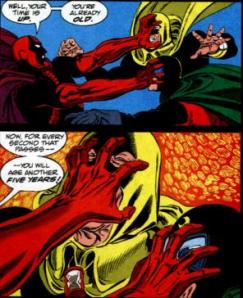 So, here is the quickest summary I can muster. Extant travels to the end of time, killing Time Trapper and causing a Crisis on Infinite Earths-style Ctrl+Z rift to go backwards through time, erasing existence (don’t think about the physics of this, it makes zero sense). Metron, Waverider, Superman, and Batman team up to attempt to stop the universe from rebooting. They get the help of every other hero in the DCU and the results are somewhat catastrophic. Wally West, Jay Garrick, Steel, most of the JSA, Dr. Mist, Vandal Savage, the Legion of Super-Heroes, and Kyle Rayner all “die.” An attempt is made at explaining what Hawkman’s deal is by stuffing all of the Thanagarians into one body (which just ends up raising more questions rather than clarifying anything). Extant is revealed to not really be the villain of the book, but was working for Hal Jordan (under the influence of Parallax) who wants to undo Coast City getting destroyed in “Reign of the Supermen.” The story ends with the universe being completely erased before the Spectre showing up to save the day (as he pretty much does in every Crisis) and the Green Arrow shooting Hal in the chest, “killing” him. The Spectre pumps newcomer Damage full of energy, causing him to act as a new Big Bang. Time goes by naturally and the universe is as it was. Sort of.
So, here is the quickest summary I can muster. Extant travels to the end of time, killing Time Trapper and causing a Crisis on Infinite Earths-style Ctrl+Z rift to go backwards through time, erasing existence (don’t think about the physics of this, it makes zero sense). Metron, Waverider, Superman, and Batman team up to attempt to stop the universe from rebooting. They get the help of every other hero in the DCU and the results are somewhat catastrophic. Wally West, Jay Garrick, Steel, most of the JSA, Dr. Mist, Vandal Savage, the Legion of Super-Heroes, and Kyle Rayner all “die.” An attempt is made at explaining what Hawkman’s deal is by stuffing all of the Thanagarians into one body (which just ends up raising more questions rather than clarifying anything). Extant is revealed to not really be the villain of the book, but was working for Hal Jordan (under the influence of Parallax) who wants to undo Coast City getting destroyed in “Reign of the Supermen.” The story ends with the universe being completely erased before the Spectre showing up to save the day (as he pretty much does in every Crisis) and the Green Arrow shooting Hal in the chest, “killing” him. The Spectre pumps newcomer Damage full of energy, causing him to act as a new Big Bang. Time goes by naturally and the universe is as it was. Sort of.
But how is this still relevant to the modern DCU? Well, remember when I said all of those characters “died?” The only ones who actually died and stayed dead were the original Atom and Doctor Mid-Nite. Wally West just got thrown through the time stream a bit, where he witnessed all the major points in his life (including his and Linda’s deaths) and gave a younger self a pep talk. Hal Jordan and Kyle Rayner didn’t really die, but got transported back to Oa. There, they had an all out fight that ended with Oa getting blown the fuck up. Aquaman got his totally 90s beard and harpoon hand after piranhas ate it off. Power Girl has a baby which is pretty much never heard from again. The biggest impact, however, was probably to Green Arrow. Thinking that he’d just killed Hal Jordan, Ollie threw his costume into the sea, went back to the monastery he joined in Flash #218, and meets Connor Hawke, his son, for the first time.
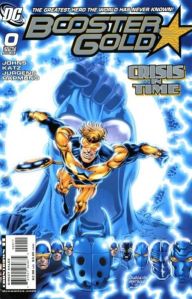 Some of the strangest tie-ins, however, had to be in both Neil Gaiman’s Sandman and Geoff Johns’ Booster Gold. In Sandman: Worlds’ End, a group of inter-dimensional travelers sit in a bizarre inn and wait out the “reality storm” caused by Parallax in Zero Hour (without ever directly mentioning it). Even stranger is April 2008’s Booster Gold #0, in which Booster, Dan Gerrett, Ted Kord, Jamie Reyes, and an unnamed fourth Blue Beetle from the 57th century stumble across Extant and Parallax discussing why they didn’t want Alan Scott dead. After a brief fight, Booster and the Beetles (ha) zap themselves away to the time of Booster’s origin, making its premise similar to the #0 books of 14 years prior.
Some of the strangest tie-ins, however, had to be in both Neil Gaiman’s Sandman and Geoff Johns’ Booster Gold. In Sandman: Worlds’ End, a group of inter-dimensional travelers sit in a bizarre inn and wait out the “reality storm” caused by Parallax in Zero Hour (without ever directly mentioning it). Even stranger is April 2008’s Booster Gold #0, in which Booster, Dan Gerrett, Ted Kord, Jamie Reyes, and an unnamed fourth Blue Beetle from the 57th century stumble across Extant and Parallax discussing why they didn’t want Alan Scott dead. After a brief fight, Booster and the Beetles (ha) zap themselves away to the time of Booster’s origin, making its premise similar to the #0 books of 14 years prior.
Anyways, congratulations, whoever you are! You are now an expert in all things Zero Hour and never, ever have to read it.
